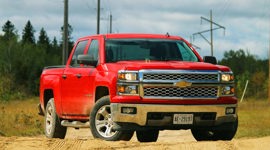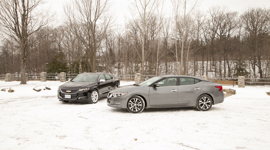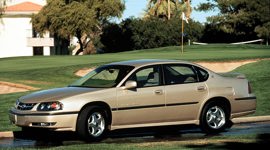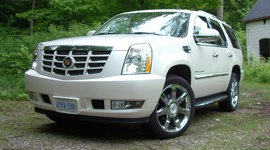Vehicle Type
Owners and reviewers alike impressed with comfort levels, real-life fuel economy, strong performance from the V6 engine, and an overall ride and handling balance nicely tuned for the long-distance driver.
Full-size sedan
History/Description
The latest generation of Chevrolet Impala hit the road some five years ago for model year 2014, representing a complete, ground-up overhaul of the brand’s largest four-door car. Combining reasonable pricing, plenty of space, and a new suite of technology, design, and safety implements, the Impala represented a compelling product for the shopper after a traditional large sedan with all modern must-haves.
Owners and reviewers agreed: The Impala is an excellent road-trip machine, and one that packs a comfortable ride over almost anything, decent performance, great real-world mileage, and heaps of room for four adults and their things.
Depending on the year and model selected, equipment content may include up-level audio provisions, Bluetooth, navigation, automatic lights, climate-controlled seats, push-button start, remote start, OnStar, active noise cancellation, and more.
Safety-conscious shoppers will appreciate the 10 standard airbags, and a full suite of available or standard safety features, including outward-looking hazard detection systems like blind-spot monitoring and lane-departure warning.
Look for an available built-in Wi-Fi hotspot starting from 2015. Android Auto and wireless charging joined the feature list from 2016.
Engines
Impala offered four- or six-cylinder power, by way of a 2.5-litre four-cylinder, good for 196 horsepower, or the (highly advised) 3.6-litre V6, with 305 horsepower. Some models offered a 2.4-litre four-cylinder engine with a light-hybrid eAssist system as well. All models ran an automatic transmission and were front-wheel drive.
What Owners Like
Impala seems to have impressed owners and reviewers alike with comfort levels, real-life fuel economy, strong performance from the V6 engine, and an overall ride and handling balance nicely tuned for the long-distance driver. Easy to use technology and logical interfaces were also appreciated, as was the Impala’s tidy and nicely trimmed cabin. A generous trunk and rear-seat space helped round out the package.
What Owners Dislike
Common gripes include limited headroom for taller occupants on models with the sunroof, slim side mirrors that may not offer quite enough rearward view for some drivers, and a dated, boring-looking instrument cluster readout.
Here are some owner reviews.
Pro Tip
Which engine to choose? We recommend the V6. Not only does it pack a punch with 305 horsepower, but real-life fuel economy has proved impressive, too. Here’s an engine with power to spare, and one that won’t empty your wallet when it’s time to fill up.
Here’s Your Test Drive To-Do List
Check the Displays and Radio
On your Impala test drive, be sure to give all displays and interfaces a good workout – playing music from various sources, confirming compatibility with your smartphone, plotting a navigation destination, toggling through the driver computer, connecting to OnStar, and more. Some owners have reported wonky display interfaces and readouts that may freeze or crash, possibly when certain devices are connected, or when certain functions are activated. A hard-reset of the system may fix the problem, or (pricier) new componentry may be required. Though reported somewhat rarely, issues with on-board electronics like this can be pricey to address, so you’ll want to know about them before you buy. Dealerships may have access to a Technical Service Bulletin (TSB) to help speed assessment and repair if this problem is detected.
Drive with Your Ears
Though issues are reported too rarely to warrant widespread concern, some owners have reported the need to have various steering and suspension components replaced at fairly low mileage. Shoppers are advised to spend as much of their test drive as possible on a rough road, listening intently for clunking, popping, banging, or rattling sounds from beneath the vehicle, especially if said unit is a higher-mileage machine. Any unwelcome sounds should be investigated before purchase. Further coax problematic sounds from the steering and suspension by running the engine, parking, and turning the wheel fully from one side to another, several times, and at different speeds. Any popping or clunking detected during this exercise should be investigated, as they could be caused by worn components.
Check for Taillamp Leaks
Look closely into the Impala’s taillamps for signs of a somewhat common water leak, which is likely caused by a failed gasket. Over time, the gasket on some Impala taillight assemblies can fail, allowing water to enter the taillamp assembly, where it can cause mould, poor light transmission, or corrosion to the wiring. This leak may also allow water to enter the Impala’s trunk, where it could result in mould, odour, and other issues. Fully check the taillamps, and the trunk (including the area beneath the cargo floor cover) for signs of current or past water damage. Have a dealer address the issue if you detect it.
Check the Blind-Spot Monitoring System
Numerous owners have reported issues with non-functional blind-spot monitoring, which may present itself via flashing warning lights on the mirrors, error messages in the instrument cluster, or random illumination of the warning light for no apparent reason. This problem is remedied by having a dealer install a new module, or in some cases, reprogram the existing one. Note that in the discussion thread above, some owners suggest installing the new module at home to avoid labour charges, or suggest disconnecting and reconnecting the battery to fix this problem. Neither course of action is advisable: modules need to be programmed to the specific vehicle in order to work properly, and interrupting battery power doesn’t reset problems like this, and can cause issues in other vehicle electronics. The gist? If a complex system like blind-spot monitoring is acting up, having a dealer address it is the best course of action.
Look for Transmission Issues
Pay close attention to the transmission on the Impala you’re considering and be on the lookout for possible trouble signs. Some owners have reported a shuddering or hesitation sensation when accelerating gently up an incline as a precursor to transmission problems. Any struggling, hesitation, slipping, hard shifting, or difficulty engaging the proper gear can be a sign of trouble, though this issue hasn’t been reported with sufficient frequency, against total sales volume, to cause much worry. Still, protect yourself from expensive repairs by confirming that all transmission servicing (fluid changes) are up to date, that no trouble codes are in play with the transmission (a diagnostic scan will reveal this).
Report any transmission-related problems to a dealer for investigation and documentation as soon as possible if detected, to help speed future warranty repairs if needed.
Here’s some more reading. Also, note that often times, transmission problems like those listed above can be remedied with updated transmission control software, and don’t necessarily indicate a mechanical or internal problem.
Other Useful Information
Bring Your VIN
After purchasing the Impala you’re considering, (or while at a GM dealer for a Pre-Purchase Inspection), provide the VIN number of the Impala to a service advisor and ask whether any software updates or recall campaigns may be outstanding. Software updates can address or prevent possible issues with a multitude of vehicle components, fixing issues with anything from battery drain to poor fuel mileage to hard shifting from the transmission, and more. Recall campaigns involve some corrective action performed by the dealer, free of charge, to address latent issues that may affect vehicle safety.
Impala has no fewer than eight recall campaigns, so be sure to have any applicable recall work completed as soon as possible. Note that a dealer may require consent of the vehicle’s owner to look up recall or software update information, if you visit before buying the vehicle.
Report Problems Early
If you detect a problem with your in-warranty Impala, be sure to have a dealer investigate the problem, and obtain documentation to that effect, as soon as possible. This is especially important if the vehicle’s warranty is approaching expiration. Early reporting and documentation of problems can speed future warranty claims if needed, sometimes, even if the problem worsens after the warranty expires.
The Verdict
With most common problems being fairly minor in nature, and most bigger problems being reported with insufficient frequency to cause major alarm, the latest-generation Impala, thus far, seems like a solid used bet in a big, comfortable sedan, but a full look-over by a GM technician ahead of purchase is highly advised.
Crash Test Ratings
IIHS: test results here
NHTSA: 5/5 Stars

















































